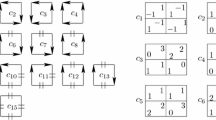Abstract
We study the computational aspects of weak saddles, an ordinal set-valued solution concept proposed by Shapley. F. Brandt et al. recently gave a polynomial-time algorithm for computing weak saddles in a subclass of matrix games, and showed that certain problems associated with weak saddles of bimatrix games are NP-hard. The important question of whether weak saddles can be found efficiently was left open. We answer this question in the negative by showing that finding weak saddles of bimatrix games is NP-hard, under polynomial-time Turing reductions. We moreover prove that recognizing weak saddles is coNP-complete, and that deciding whether a given action is contained in some weak saddle is hard for parallel access to NP and thus not even in NP unless the polynomial hierarchy collapses. Most of our hardness results are shown to carry over to a natural weakening of weak saddles.
Similar content being viewed by others
References
Basu, K., Weibull, J.: Strategy subsets closed under rational behavior. Econ. Lett. 36, 141–146 (1991)
Baumeister, D., Brandt, F., Fischer, F., Hoffmann, J., Rothe, J.: The complexity of computing minimal unidirectional covering sets. In: Proceedings of the 7th International Conference on Algorithms and Complexity (CIAC). Lecture Notes in Computer Science (LNCS), vol. 6078, pp. 299–310. Springer, Berlin (2010)
Bernheim, B.: Rationalizable strategic behavior. Econometrica 52(4), 1007–1028 (1984)
Brandt, F., Fischer, F.: Computing the minimal covering set. Math. Soc. Sci. 56(2), 254–268 (2008)
Brandt, F., Brill, M., Fischer, F., Harrenstein, P.: Computational aspects of Shapley’s saddles. In: Proceedings of the 8th International Joint Conference on Autonomous Agents and Multi-Agent Systems (AAMAS), pp. 209–216 (2009)
Brandt, F., Brill, M., Fischer, F., Harrenstein, P.: On the complexity of iterated weak dominance in constant-sum games. Theory Comput. Syst. (2010). doi:10.1007/s00224-010-9282-7
Chen, X., Deng, X., Teng, S.-H.: Settling the complexity of computing two-player Nash equilibria. J. ACM 56(3) (2009)
Conitzer, V., Sandholm, T.: Complexity of (iterated) dominance. In: Proceedings of the 6th ACM Conference on Electronic Commerce (ACM-EC), pp. 88–97. ACM Press, New York (2005)
Daskalakis, C., Goldberg, P., Papadimitriou, C.: The complexity of computing a Nash equilibrium. SIAM J. Comput. 39(1), 195–259 (2009)
Duggan, J., Le Breton, M.: Dutta’s minimal covering set and Shapley’s saddles. J. Econ. Theory 70, 257–265 (1996)
Dutta, B.: Covering sets and a new Condorcet choice correspondence. J. Econ. Theory 44, 63–80 (1988)
Gilboa, I., Kalai, E., Zemel, E.: The complexity of eliminating dominated strategies. Math. Oper. Res. 18(3), 553–565 (1993)
Hemaspaandra, E., Hemaspaandra, L., Rothe, J.: Exact analysis of Dodgson elections: Lewis Carroll’s 1876 voting system is complete for parallel access to NP. J. ACM 44(6), 806–825 (1997)
Luce, R.D., Raiffa, H.: Games and Decisions: Introduction and Critical Survey. Wiley, New York (1957)
McKelvey, R.D., Ordeshook, P.C.: Symmetric spatial games without majority rule equilibria. Am. Polit. Sci. Rev. 70(4), 1172–1184 (1976)
Myerson, R.B.: Game Theory: Analysis of Conflict. Harvard University Press, Harvard (1991)
Nash, J.F.: Non-cooperative games. Ann. Math. 54(2), 286–295 (1951)
Papadimitriou, C.H.: Computational Complexity. Addison-Wesley, Reading (1994)
Pearce, D.: Rationalizable strategic behavior and the problem of perfection. Econometrica 52(4), 1029–1050 (1984)
Samuelson, L.: Dominated strategies and common knowledge. Games Econ. Behav. 4, 284–313 (1992)
Shapley, L.: Order matrices, I. Technical Report RM-1142, The RAND Corporation (1953a)
Shapley, L.: Order matrices, II. Technical Report RM-1145, The RAND Corporation (1953b)
Shapley, L.: Some topics in two-person games. In: Dresher, M., Shapley, L.S., Tucker, A.W. (eds.) Advances in Game Theory. Annals of Mathematics Studies, vol. 52, pp. 1–29. Princeton University Press, Princeton (1964)
von Neumann, J.: Zur Theorie der Gesellschaftspiele. Math. Ann. 100, 295–320 (1928)
von Neumann, J., Morgenstern, O.: Theory of Games and Economic Behavior. Princeton University Press, Princeton (1944)
Wagner, K.: More complicated questions about maxima and minima, and some closures of NP. Theor. Comput. Sci. 51, 53–80 (1987)
Author information
Authors and Affiliations
Corresponding author
Rights and permissions
About this article
Cite this article
Brandt, F., Brill, M., Fischer, F. et al. The Computational Complexity of Weak Saddles. Theory Comput Syst 49, 139–161 (2011). https://doi.org/10.1007/s00224-010-9298-z
Published:
Issue Date:
DOI: https://doi.org/10.1007/s00224-010-9298-z




